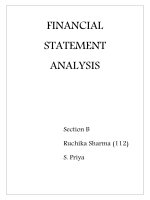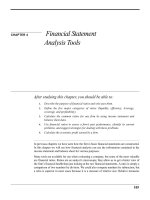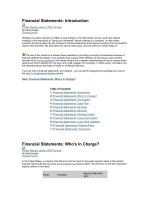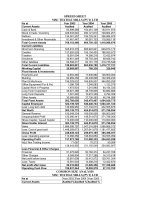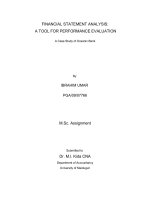Financial statement analysis workbook
Bạn đang xem bản rút gọn của tài liệu. Xem và tải ngay bản đầy đủ của tài liệu tại đây (2.25 MB, 209 trang )
P1: OTA/XYZ
JWBT510-fm
P2: ABC
JWBT510-Fridson
May 23, 2011
ib
7:24
Printer: Yet to Come
P1: OTA/XYZ
JWBT510-fm
P2: ABC
JWBT510-Fridson
May 23, 2011
7:24
Printer: Yet to Come
Additional Praise for
Financial Statement Analysis, Fourth Edition
“This is an illuminating and insightful tour of financial statements, how they
can be used to inform, how they can be used to mislead, and how they can
be used to analyze the financial health of a company.”
—Jay O. Light, Dean Emeritus, Harvard Business School
“Financial Statement Analysis should be required reading for anyone who
puts a dime to work in the securities markets or recommends that others do
the same.”
—Jack L. Rivkin, Director, Neuberger Berman Mutual Funds and Idealab
“Fridson and Alvarez provide a valuable practical guide for understanding,
interpreting, and critically assessing financial reports put out by firms. Their
discussion of profits—‘quality of earnings’—is particularly insightful given
the recent spate of reporting problems encountered by firms. I highly recommend their book to anyone interested in getting behind the numbers as a
means of predicting future profits and stock prices.”
—Paul Brown, Associate Dean, Executive MBA Programs,
Leonard N. Stern School of Business, New York University
“Let this book assist in financial awareness and transparency and higher
standards of reporting, and accountability to all stakeholders.”
—Patricia A. Small, Treasurer Emeritus, University of California;
Partner, KCM Investment Advisors
“This book is a polished gem covering the analysis of financial statements.
It is thorough, skeptical, and extremely practical in its review.”
—Daniel J. Fuss, Vice Chairman, Loomis, Sayles & Company, LP
ia
P1: OTA/XYZ
JWBT510-fm
P2: ABC
JWBT510-Fridson
May 23, 2011
ib
7:24
Printer: Yet to Come
P1: OTA/XYZ
JWBT510-fm
P2: ABC
JWBT510-Fridson
May 23, 2011
7:24
Printer: Yet to Come
Financial Statement
Analysis Workbook
i
P1: OTA/XYZ
JWBT510-fm
P2: ABC
JWBT510-Fridson
May 23, 2011
7:24
Printer: Yet to Come
Founded in 1807, John Wiley & Sons is the oldest independent publishing company in the United States. With offices in North America, Europe,
Australia and Asia, Wiley is globally committed to developing and marketing
print and electronic products and services for our customers’ professional
and personal knowledge and understanding.
The Wiley Finance series contains books written specifically for finance
and investment professionals as well as sophisticated individual investors
and their financial advisors. Book topics range from portfolio management
to e-commerce, risk management, financial engineering, valuation and financial instrument analysis, as well as much more.
For a list of available titles, visit our Web site at www.WileyFinance.com.
ii
P1: OTA/XYZ
JWBT510-fm
P2: ABC
JWBT510-Fridson
May 23, 2011
7:24
Printer: Yet to Come
Financial Statement
Analysis Workbook
Step-by-Step Exercises and
Tests to Help You Master
Financial Statement Analysis
Fourth Edition
MARTIN FRIDSON
FERNANDO ALVAREZ
John Wiley & Sons, Inc.
iii
P1: OTA/XYZ
JWBT510-fm
P2: ABC
JWBT510-Fridson
May 27, 2011
4:5
Printer: Yet to Come
Copyright c 2011 by Martin Fridson and Fernando Alvarez. All rights reserved.
Published by John Wiley & Sons, Inc., Hoboken, New Jersey.
Published simultaneously in Canada.
No part of this publication may be reproduced, stored in a retrieval system, or transmitted in
any form or by any means, electronic, mechanical, photocopying, recording, scanning, or
otherwise, except as permitted under Section 107 or 108 of the 1976 United States Copyright
Act, without either the prior written permission of the Publisher, or authorization through
payment of the appropriate per-copy fee to the Copyright Clearance Center, Inc.,
222 Rosewood Drive, Danvers, MA 01923, (978) 750-8400, fax (978) 646-8600, or on the
Web at www.copyright.com. Requests to the Publisher for permission should be addressed to
the Permissions Department, John Wiley & Sons, Inc., 111 River Street, Hoboken, NJ 07030,
(201) 748-6011, fax (201) 748-6008, or online at />Limit of Liability/Disclaimer of Warranty: While the publisher and author have used their
best efforts in preparing this book, they make no representations or warranties with respect to
the accuracy or completeness of the contents of this book and specifically disclaim any implied
warranties of merchantability or fitness for a particular purpose. No warranty may be created
or extended by sales representatives or written sales materials. The advice and strategies
contained herein may not be suitable for your situation. You should consult with a
professional where appropriate. Neither the publisher nor author shall be liable for any loss
of profit or any other commercial damages, including but not limited to special, incidental,
consequential, or other damages.
For general information on our other products and services or for technical support, please
contact our Customer Care Department within the United States at (800) 762-2974, outside
the United States at (317) 572-3993 or fax (317) 572-4002.
Wiley also publishes its books in a variety of electronic formats. Some content that appears in
print may not be available in electronic books. For more information about Wiley products,
visit our web site at www.wiley.com.
ISBN 978-0-470-64003-6 (paperback); ISBN 978-1-118-09749-6 (ebk);
ISBN 978-1-118-09747-2 (ebk); ISBN 978-1-118-09748-9 (ebk)
Printed in the United States of America.
10
9
8
7
6
5
4
3
2
1
iv
P1: OTA/XYZ
JWBT510-fm
P2: ABC
JWBT510-Fridson
May 23, 2011
7:24
Printer: Yet to Come
In memory of my father, Harry Yale Fridson, who
introduced me to accounting, economics, and logic,
as well as the fourth discipline essential to the
creation of this book—hard work!
M. F.
For Shari, Virginia, and Armando.
F. A.
v
P1: OTA/XYZ
JWBT510-fm
P2: ABC
JWBT510-Fridson
May 23, 2011
vi
7:24
Printer: Yet to Come
P1: OTA/XYZ
JWBT510-fm
P2: ABC
JWBT510-Fridson
May 23, 2011
7:24
Printer: Yet to Come
Contents
Preface
ix
Acknowledgments
xi
PART ONE
Questions
Questions on Each Chapter
3
Financial Statement Exercises
39
Computational Exercises
83
PART TWO
Answers
Answers to Questions on Each Chapter
105
Financial Statement Exercises
139
Computational Exercises
167
vii
P1: OTA/XYZ
JWBT510-fm
P2: ABC
JWBT510-Fridson
May 23, 2011
viii
7:24
Printer: Yet to Come
P1: OTA/XYZ
P2: ABC
JWBT510-Preface
JWBT510-Fridson
May 9, 2011
14:31
Printer: Yet to Come
Preface to Fourth Edition Workbook
his fourth edition of Financial Statement Analysis, like its predecessors,
seeks to equip its readers for practical challenges of contemporary business. Once again, the intention is to acquaint readers who have already
acquired basic accounting skills with the complications that arise in applying textbook-derived knowledge to the real world of extending credit and
investing in securities. Just as a swiftly changing environment necessitated
extensive revisions and additions in the second edition, new concerns and
challenges for users of financial statements have accompanied the dawn of
the twenty-first century.
For one thing, corporations have shifted their executive compensation
plans increasingly toward rewarding senior managers for “enhancing shareholder value.” This lofty-sounding concept has a dark side. Chief executive
officers who are under growing pressure to boost their corporations’ share
prices can no longer increase their bonuses by goosing reported earnings
through financial reporting tricks that are transparent to the stock market.
They must instead devise more insidious methods that gull investors into
believing that the reported earnings gains are real. In response to this trend,
we have expanded our survey of revenue recognition gimmicks designed to
deceive the unwary.
Another innovation that demands increased vigilance by financial analysts is the conversion of stock market proceeds into revenues. In terms of
accounting theory, this kind of transformation is the equivalent of alchemy.
Companies generate revenue by selling goods or services, not by selling their
own shares to the public.
During the Internet stock boom of the late 1990s, however, clever operators found a way around that constraint. Companies took the money
they raised in initial public offerings, bought advertising on one another’s
web sites, and recorded the shuttling of dollars as sales. Customers were
superfluous to the revenue recognition process. In another variation on the
theme, franchisers sold stock, lent the proceeds to franchisees, then immediately had the cash returned under the rubric of fees. By going out for a short
stroll and coming back, the proceeds of a financing mutated into revenues.
The artificial nature of these revenues becomes apparent when readers combine an understanding of accounting principles with a corporate
T
ix
P1: OTA/XYZ
P2: ABC
JWBT510-Preface
JWBT510-Fridson
x
May 9, 2011
14:31
Printer: Yet to Come
PREFACE
finance perspective. We facilitate such integration of disciplines throughout
Financial Statement Analysis, making excursions into economics and business management as well. In addition, we encourage analysts to consider
the institutional context in which financial reporting occurs. Organizational
pressures result in divergences from elegant theories, both in the conduct of
financial statement analysis and in auditors’ interpretations of accounting
principles. The issuers of financial statements also exert a strong influence
over the creation of the financial principles, with powerful politicians sometimes carrying their water.
A final area in which the new edition offers a sharpened focus involves
success stories in the critical examination of financial statements. Wherever
we can find the necessary documentation, we show not only how a corporate debacle could have been foreseen through application of basis analytical
techniques, but also how practicing analysts actually did detect the problem
before it became widely recognized. Readers will be encouraged by these
examples, we hope, to undertake genuine, goal-oriented analysis, instead of
simply going through the motions of calculating standard financial ratios.
Moreover, the case studies should persuade them to stick to their guns when
they spot trouble, despite management’s predictable litany. (“Our financial statements are consistent with generally accepted accounting principles.
They have been certified by one of the world’s premier auditing firms. We
will not allow a band of greedy short-sellers to destroy the value created by
our outstanding employees.”) Typically, as the vehemence of management’s
protests increases, conditions deteriorate and accusations of aggressive accounting give way to revelations of fraudulent financial reporting.
The principles and theories put forth in the University Edition of Financial Statement Analysis, fourth edition, are reinforced through the questions
and exercises in this workbook. Part One, Questions, provides chapter-bychapter fill-in-the-blank questions, financial statement exercises, and computational exercises. They are designed to be thought-provoking exercises
requiring analysis and synthesis of the concepts covered in the book. In
short, these questions do not call for “regurgitation of information.”
The answers to all questions can be found in Part Two. Answers are provided in boldfaced, italic type in order to facilitate the checking of answers
and comprehension of the material.
Financial markets continue to evolve, but certain phenomena appear
again and again in new guises. In this vein, companies never lose their resourcefulness in finding new ways to skew perceptions of their performance.
By studying their methods closely, analysts can potentially anticipate the
variations on old themes that will materialize in years to come.
MARTIN FRIDSON
FERNANDO ALVAREZ
P1: OTA/XYZ
JWBT510-ack
P2: ABC
JWBT510-Fridson
May 18, 2011
7:51
Printer: Yet to Come
Acknowledgments
Mukesh Agarwal
John Bace
Mimi Barker
Mitchell Bartlett
Richard Bernstein
Richard Byrne
Richard Cagney
George Chalhoub
Tiffany Charbonier
Sanford Cohen
Margarita Declet
Mark Dunham
Kenneth Emery
Bill Falloon
Sylvan Feldstein
David Fitton
Thomas Flynn III
Daniel Fridson
Igor Fuksman
Ryan Gelrod
Kenneth Goldberg
Susannah Gray
Evelyn Harris
David Hawkins
Emilie Herman
Avi Katz
Rebecca Keim
James Kenney
Andrew Kroll
Les Levi
Ross Levy
Michael Lisk
David Lugg
Jennie Ma
Stan Manoukian
Michael Marocco
Tom Marshella
Eric Matejevich
John Mattis
Pat McConnell
Oleg Melentyev
Krishna Memani
Ann Marie Mullan
Kingman Penniman
Stacey Rivera
Richard Rolnick
Clare Schiedermayer
Gary Schieneman
Bruce Schwartz
Devin Scott
David Shapiro
Elaine Sisman
Charles Snow
Vladimir Stadnyk
John Thieroff
Scott Thomas
John Tinker
Kivin Varghese
Diane Vazza
Pamela Van Giessen
Sharyl Van Winkle
David Waill
Steven Waite
Douglas Watson
Burton Weinstein
Stephen Weiss
David Whitcomb
Mark Zand
xi
P1: OTA/XYZ
JWBT510-ack
P2: ABC
JWBT510-Fridson
May 18, 2011
xii
7:51
Printer: Yet to Come
P1: TIX/b
JWBT510-c01
P2: c/d
QC: e/f
JWBT510-Fridson
T1: g
May 24, 2011
0:16
Printer: Yet to Come
PART
One
Questions
1
P1: TIX/b
JWBT510-c01
P2: c/d
QC: e/f
JWBT510-Fridson
T1: g
May 24, 2011
2
0:16
Printer: Yet to Come
P1: TIX/b
P2: c/d
JWBT510-c01
QC: e/f
T1: g
JWBT510-Fridson
May 24, 2011
0:16
Printer: Yet to Come
Questions on Each Chapter
CHAPTER 1: THE ADVERSARIAL NATURE OF
FINANCIAL REPORTING
1. Three ways that corporations can use financial reporting to enhance
their value are:
a.
b.
c.
2. The true purpose of financial reporting is
.
3. Corporations routinely
because the appearance of
receives a higher
multiple.
4. According to the
, reversals of the excess write-offs
offer an artificial means of
in subsequent periods.
5. The following are some of the powerful limitations to continued growth
faced by companies:
a.
b.
c.
6. Some of the commonly heard rationalizations for declining growth are:
a.
b.
c.
7.
reached its zenith of popularity during the
movement of the 1960s. However, by the 1980s,
the stock market had converted the
into a
.
8.
is one of the ways that the notion of diversification as
a means of maintaining
is revived from time to time.
3
P1: TIX/b
P2: c/d
JWBT510-c01
4
QC: e/f
JWBT510-Fridson
T1: g
May 24, 2011
0:16
Printer: Yet to Come
FINANCIAL STATEMENT ANALYSIS WORKBOOK
9. The surprise element in Manville Corporation’s 1982 bankruptcy was,
in part, a function of
.
10. The analyst’s heightened awareness of legal risks are a result of
bankruptcies associated with:
a.
b.
c.
11. Some of the stories used to sell stocks to individual investors are:
a.
b. A “play” in some current economic trend such as
i.
ii.
c.
12. When the story used to sell stocks to individual investors originates
among stockbrokers or even
, the zeal with which the
story is disseminated may depend more on
than the
.
13. The ostensible purpose of financial reporting is
of a
corporation’s earnings.
14. Over a two-year period BGT paid L&H $35 million to develop translation software. L&H then bought BGT and the translation product
along with it. The net effect was that instead
, L&H
recognized
.
CHAPTER 2: THE BALANCE SHEET
1. A study conducted on behalf of Big Five accounting firm Arthur Anderand
, book
sen showed that between
value fell from
percent to
percent of
the stock market value of public companies in the United States.
2. As noted by Baruch Lev of New York University, two examples of how
traditional accounting systems are at a loss to capture most of what is
going on today are:
a.
b.
P1: TIX/b
P2: c/d
JWBT510-c01
QC: e/f
JWBT510-Fridson
Questions on Each Chapter
T1: g
May 24, 2011
0:16
Printer: Yet to Come
5
3. In the examples in Question 2 there is no accounting event because
.
4. Some of the distinct approaches that have evolved for assessing real
property are:
a.
b.
c.
5. Some financial assets are unaffected by the difficulties of evaluating
physical assets because
in
markets.
6. Under the compromise embodied in SFAS 115, financial instruments are
valued according to
by the company
.
7. If a company wrote off a billion dollars worth of goodwill, its ratio of
assets to liabilities would
. Its ratio of
would not change, however.
8. Through stock-for-stock acquisitions, the sharp rise in equity prices
during the late 1990s was transformed into
, despite
the usual assumption that
.
9. Unlike
, goodwill is not an asset that can be readily
to raise cash. Neither can a company enter into a
of its goodwill, as it can with its plant and equipment.
In short, goodwill is not
that management can either
or
to extricate itself from a financial
tight spot.
10. A reasonable estimate of a low-profit company’s true equity value would
be
.
11. Determining the cost of capital is a notoriously controversial subject in the financial field, complicated by
and
.
12. Among the advantages of market capitalization as a measure of equity
are:
a.
b.
c.
13. A limitation of the peer-group approach to valuation is that
and therefore
one major benefit of
using
as a gauge of actual equity value.
P1: TIX/b
P2: c/d
JWBT510-c01
6
QC: e/f
JWBT510-Fridson
T1: g
May 24, 2011
0:16
Printer: Yet to Come
FINANCIAL STATEMENT ANALYSIS WORKBOOK
14. Instead of striving for theoretical purity on the matter, analysts
should adopt a
, using the measure of equity value
.
15. Historical-cost-based balance sheet figures are the ones that matter in
that a company will violate
requiring
.
16. Users of financial statements can process only
, and
they do not always have
.
17. Deterioration in a company’s financial position may catch investors by
surprise because it
and is
.
CHAPTER 3: THE INCOME STATEMENT
1. Students of financial statements must keep up with
of the past few years in transforming
into
.
2. In the
, each income statement item is expressed
as
(sales or revenues), which is represented as
.
3. Besides facilitating comparisons between a company’s present and
past results, the
can highlight important facts
.
4. Even within an industry, the breakdown of expenses can vary
from company to company as a function of
and
.
5. Percentage breakdowns are also helpful for comparing a single
company’s performance with
and for comparing
on the basis of
.
6. In essence, Peet’s is more of
and Starbucks is more
involved in
.
7. Costs as percentages of sales also vary among companies within an
industry for
than differences
.
8. The more widely diversified pharmaceutical manufacturers can be expected to have
percentage
, as well
as
percentage expenses, than industry peers that focus
exclusively on
.
P1: TIX/b
P2: c/d
JWBT510-c01
QC: e/f
JWBT510-Fridson
Questions on Each Chapter
T1: g
May 24, 2011
0:16
Printer: Yet to Come
7
9. Analysts must take care not to mistake difference that is actually
as evidence of
. A subtler explanation may be available at the modest cost of
.
10. Executives whose bonuses rise
have a strong incentive
not only
, but also to use
.
11. On a retrospective basis, a surge
or
may indicate that
.
12. Along with
, another major expense category that can
be controlled through
is
.
13. An unusually low ratio of
to
with the
ratios of its industry peers may indicate that management is being unrealistic in acknowledging the pace of wear and tear on fixed assets. Understatement of
and overstatement of
would result.
14. A company knows that creating
expectations
about
can raise
and lower
.
15. One way persuading investors that a major development that hurt earnings last year will
affect earnings
is to
suggest that any
suffered by the company was somehow
, and, by implication,
.
16. An extraordinary item is reported on an
basis, below
the
from continuing operations.
17. The accounting rules prohibit corporate officials from displaying certain hits to earnings “above the line,” that is,
, and
from using the label
. Accordingly they employ designations such as
or
. These terms
have
, but
the highlighted items are
.
18. In recent years,
has become a catchall for charges that
companies wish analysts to consider
, but which do not
qualify for
.
19. Corporate managers commonly perceive that
will be
if they take (for sake of argument) a $1.5 billion writeoff than if
. The benefit of exaggerating the damage is
that in subsequent years,
.
P1: TIX/b
P2: c/d
JWBT510-c01
8
QC: e/f
JWBT510-Fridson
T1: g
May 24, 2011
0:16
Printer: Yet to Come
FINANCIAL STATEMENT ANALYSIS WORKBOOK
20. The most dangerous trap that users of financial statements must avoid
walking into, however, is inferring that the term “restructuring” connotes
.
21. The purpose of providing pro forma results was to help analysts
accurately when some event
caused
to convey a misleading impression.
22. Computer software producers got into the act by
from
the expenses considered in calculating
.
23. Unlike operating income, a concept addressed by FASB standards,
is a number that subjectively
many
that lack any standing under GAAP.
24. In fact, analysts who hope to forecast future financial results accurately
must apply
and set aside genuinely
.
25. Analysts must exercise judgment when considering pro forma earnings;
however, they must make sure to examine
, instead of
by relying solely on
.
26. An older, but not obsolete, device for beefing up reported income is
.
27. A comparatively
ratio of PP&E to
or
is another sign of potential trouble.
28. Management can
through techniques that more properly fall into the category of
.
29. One way to increase profitability through
involves
.
30. A corporation can easily accelerate its sales growth by
and
. Creating genuine value for shareholders through
is more difficult, although unwary investors sometimes
fail to recognize the distinction.
31. Analysts need to distinguish between internal growth and external
growth.
consists of sales increases generated from a
company’s existing operations, while
represents incremental sales brought in through
.
32. If Company A generates external growth by acquiring Company B and
neither Company nor its new subsidiary increases its profitability, then
the merged companies is
than the
sum of the two companies’ values.
P1: TIX/b
P2: c/d
JWBT510-c01
QC: e/f
JWBT510-Fridson
T1: g
May 24, 2011
0:16
Questions on Each Chapter
Printer: Yet to Come
9
33. In general, the
the combining businesses are,
the
it is that the hoped-for economies of scope
.
34. As synergies go, projections of economies of scale in combinations of
companies
tend to be more plausible than economies
of scope purportedly available to companies in
businesses.
35. A company with relatively large
has a
breakeven level. Even a modest economic downturn will reduce
below the rate required to keep the company
profitable.
36. Deals that work on paper have often foundered on
a.
b.
c.
d.
37. Financial statements cannot capture certain
that may
be essential to
. These include
a.
b.
c.
CHAPTER 4: THE STATEMENT OF CASH FLOWS
1. The present version of the statement that traces the flow of funds
in and out of the firm, the statement of cash flows, became manda, for issuers with fiscal years ending after
tory, under
.
2. For financial-reporting (as opposed to
) purposes, a
publicly owned company generally seeks to maximize
,
which investors use as a basis for valuing its shares.
3. A privately held company, unlike a
, which shows one
set of statements to the public and another to the Internal Revenue
Service, a private company typically prepares
of statements, with
foremost in its thinking. Its incentive is




